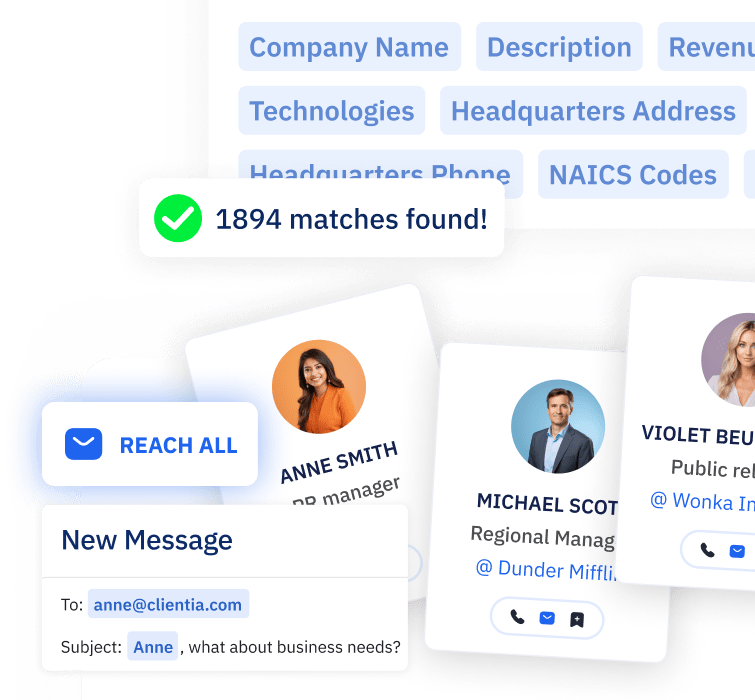When SDRs and AEs don’t work in tandem, deals are lost.
It’s tempting to focus 100% of your effort on your own responsibilities and quota, but teamwork is necessary to bring the individual pieces together. While all roles in the sales process have their importance, they can’t function separately. In order to be successful, part of your job needs to be assisting the rest of your sales team.
In this guide, we’re sharing 6 crucial tips for successful SDR – AE relationships to help you work more closely as a team, raise your team’s efficiency and ultimately help close more deals.
leave no lead unexplored
Every potential client within reach
- 180m+ contacts
- CRM integrations
- 23 Prospect filters
- 15 Company filters
Tired of reading? Watch the video instead

What AEs and SDRs do
Before we dive deeper, let’s make sure that we’re on the same page and get clear with the roles of AEs and SDRs. AEs and SDRs have specific responsibilities, quotas, and KPIs to address.
An SDR (sales development representative) is responsible for pipeline building and prospecting, both inbound and outbound. This role focuses on customer retainment, prioritizing existing customers while allowing the sales reps to focus on making new sales. On the other hand, an AE (account executive) focuses on active opportunities and guiding the client down the sales funnel to convert them from a lead into a customer.
AEs work with high-opportunity deals and hone in on understanding a lead’s needs. AE’s job calls for profound product knowledge and ability to recognize potential opportunities for up and cross-selling.
Basically, sales development reps are in charge of scheduling meetings for the account executives. However, before passing the leads to AEs, SDRs make sure that the leads are qualified by organizing an initial meeting. Then, an AE moves on to develop relationships with those leads and nurture them.
Importance of a strong SDR – AE relationship
Without your SDR team and AE team working in perfect harmony, you risk missing significant opportunities and losing lucrative deals. On the flip side, when both the SDR and AE teams realize the benefit of working together, chances are high that more sales will be closed.
SDR and AE relationship: 6 steps to bring it to the next level
1. Establish a clear SLA (service level agreement)
One of the most important things you can do to encourage a harmonious AE – SDR relationship is to set expectations from the start. One of the best ways to do this is to agree upon a service level agreement.
The goal is to have both parties understand and accept their own responsibilities and to know what they can expect from the other.
For example: What constitutes an SQL (sales qualified lead)? When should the handoff occur? What information is needed when passing a lead?, etc. Make sure you both are on the same page before moving forward to avoid any dropped leads or mistakes.
2. Stay organized
The sales cycle already has a lot of uncontrollable factors, so one of the best things you can do to strengthen your SDR – AE relationships is to keep yourself organized. Go one step beyond the SLA and create a personal organization system for yourself.
For example: the first thing you do after a call is track it in the CRM, then set up a calendar invite, etc. Create a system for yourself that will make sure you don’t drop anything important. This will help you stay more organized, and, as a result, it will be a lot easier to pass information.
3. Establish the CRM as the source of truth
You probably have your own preferences for taking notes and remembering dates, but all of that data eventually needs to end up in your team’s CRM. Among multiple reasons sales leaders use CRMs is that they allow you to sync company and contact data in just a single click.
To make sure your SDRs and AEs stay organized, establish the notion that “if it’s not in the CRM, it doesn’t exist.” SDRs can input the data the AEs will need to work with target accounts, and AE’s job will be to input the information they obtain from the qualified meeting. If either your sales development representatives or account executives log data incorrectly, important steps in the process can be missed. But if you track everything correctly, your bases are covered.

4. Communicate daily
Open communication is the foundation of any successful relationship, SDR – AE relationships being no exception. Both sides should be committed to communicating regularly throughout the day.
From quick notes on Slack (or mobile apps alike) to regular debriefs after calls and meetings, actively reach out to your partner via instant messaging and calls and keep them looped in. If you regularly include your teammates in what you’re doing, they’ll end up reciprocating.
Seek, pick, and reach
Connect with your potential customers
- 180m+ contacts
- Advanced filtering
- Multichannel sequences
- CRM integrations
5. Schedule a weekly one-on-one
Daily communication is important, but you will also want to go for depth as well as frequency. Try scheduling a weekly one-on-one to catch up and improve the SDR – AE cooperation.
Throughout the week, take regular notes on what’s working well and which areas need improvement. Also, get into the routine of completing pre-call plans.
(A pre-call plan is a snapshot of the prospect you’re about to make a discovery call with.) Once the initial meetings and discovery calls have been scheduled, review pre-call plans to have more control over the process and demonstrate more confidence in your prospects.
A regular one-on-one will provide deeper insight into current opportunities in the pipeline, what has recently worked, what hasn’t and if you need to change your plan of attack.
6. Give encouragement and positive feedback
Sales can be a lot of fun, but it also has its downs. Some days are tougher than others, and you’ll both need some encouragement along the way. There will be days when the SDR isn’t providing qualified leads, and other times when the AE simply isn’t closing deals.
Another practice used by the best teams is giving positive feedback where it’s deserved, and providing encouragement where it’s needed. If you can establish you’re both on the same team, your team will work better through both the highs and lows.
Parting thoughts
Without any doubt, sales call for a strategic approach, the relationship within your sales team being crucial for success. Companies where SDRs support account executives by making inbound and outbound sales at scale, have a distinct edge.
They are more certain to carry out successful prospecting, superbly handle inbound and outbound efforts, build efficient pipelines, and, naturally, close more deals.
Fortunately, a fruitful relationship is not that challenging to achieve. A clearly defined service level agreement, being organized at all times, and viewing your CRM as a single source of truth can go a long way towards a productive SDR – AE partnership.
Last but not least, it’s essential that SDR and AE contact each other on a regular basis to stay on the same page. For more insights, read our article about how to build an efficient SDR team.























